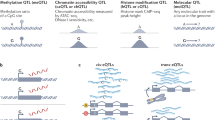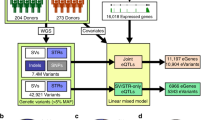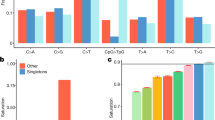Abstract
Functional polymorphism in genes can be classified as coding variation, altering the amino-acid sequence of the encoded protein, or regulatory variation, affecting the level or pattern of expression of the gene. Coding variation can be recognized directly from DNA sequence, and consequently its frequency and characteristics have been extensively described. By contrast, virtually nothing is known about the extent to which gene regulation varies in populations. Yet it is likely that regulatory variants are important in modulating gene function: alterations in gene regulation have been proposed to influence disease susceptibility and to have been the primary substrate for the evolution of species1. Here, we report a systematic study to assess the extent of cis-acting regulatory variation in 69 genes across four inbred mouse strains. We find that at least four of these genes show allelic differences in expression level of 1.5-fold or greater, and that some of these differences are tissue specific. The results show that the impact of regulatory variants can be detected at a significant frequency in a genomic survey and suggest that such variation may have important consequences for organismal phenotype and evolution. The results indicate that larger-scale surveys in both mouse and human could identify a substantial number of genes with common regulatory variation.
This is a preview of subscription content, access via your institution
Access options
Subscribe to this journal
Receive 12 print issues and online access
$209.00 per year
only $17.42 per issue
Buy this article
- Purchase on Springer Link
- Instant access to full article PDF
Prices may be subject to local taxes which are calculated during checkout


Similar content being viewed by others
Accession codes
References
King, M.C. & Wilson, A.C. Evolution at two levels in humans and chimpanzees. Science 188, 107–116 (1975).
Cargill, M. et al. Characterization of single-nucleotide polymorphisms in coding regions of human genes. Nat. Genet. 22, 231–238 (1999).
Cambien, F. et al. Sequence diversity in 36 candidate genes for cardiovascular disorders. Am. J. Hum. Genet. 65, 183–191 (1999).
Li, W.H. & Sadler, L.A. Low nucleotide diversity in man. Genetics 129, 513–523 (1991).
Halushka, M.K. et al. Patterns of single-nucleotide polymorphisms in candidate genes for blood-pressure homeostasis. Nat. Genet. 22, 239–247 (1999).
Singer-Sam, J. Quantitation of specific transcripts by RT–PCR SNuPE assay. PCR Methods Appl. 3, S48–S50 (1994).
Szabo, P.E. & Mann, J.R. Allele-specific expression and total expression levels of imprinted genes during early mouse development: implications for imprinting mechanisms. Genes Dev. 9, 3097–3108 (1995).
Lindblad-Toh, K. et al. Large-scale discovery and genotyping of single-nucleotide polymorphisms in the mouse. Nat. Genet. 24, 381–386 (2000).
Syvanen, A.C., Aalto-Setala, K., Harju, L., Kontula, K. & Soderlund, H. A primer-guided nucleotide incorporation assay in the genotyping of apolipoprotein E. Genomics 8, 684–692 (1990).
Kobayashi, M. et al. Fluorescence-based DNA minisequence analysis for detection of known single-base changes in genomic DNA. Mol. Cell. Probes 9, 175–182 (1995).
Pastinen, T., Kurg, A., Metspalu, A., Peltonen, L. & Syvanen, A.C. Minisequencing: a specific tool for DNA analysis and diagnostics on oligonucleotide arrays. Genome Res. 7, 606–614 (1997).
Chen, X., Zehnbauer, B., Gnirke, A. & Kwok, P.Y. Fluorescence energy transfer detection as a homogeneous DNA diagnostic method. Proc. Natl Acad. Sci. USA 94, 10756–10761 (1997).
Landegren, U., Nilsson, M. & Kwok, P.Y. Reading bits of genetic information: methods for single-nucleotide polymorphism analysis. Genome Res. 8, 769–776 (1998).
Kennedy, B.P. et al. A natural disruption of the secretory group II phospholipase A2 gene in inbred mouse strains. J. Biol. Chem. 270, 22378–22385 (1995).
Lander, E.S. et al. Initial sequencing and analysis of the human genome. Nature 409, 860–921 (2001).
Bosma, P.J. et al. The genetic basis of the reduced expression of bilirubin UDP-glucuronosyltransferase 1 in Gilbert's syndrome. N. Engl. J. Med. 333, 1171–1175 (1995).
Monaghan, G., Ryan, M., Seddon, R., Hume, R. & Burchell, B. Genetic variation in bilirubin UPD-glucuronosyltransferase gene promoter and Gilbert's syndrome. Lancet 347, 578–581 (1996).
Grosveld, F., van Assendelft, G.B., Greaves, D.R. & Kollias, G. Position-independent, high-level expression of the human β-globin gene in transgenic mice. Cell 51, 975–985 (1987).
Dillon, N., Trimborn, T., Strouboulis, J., Fraser, P. & Grosveld, F. The effect of distance on long-range chromatin interactions. Mol. Cell 1, 131–139 (1997).
Li, Q., Harju, S. & Peterson, K.R. Locus control regions: coming of age at a decade plus. Trends Genet. 15, 403–408 (1999).
Rave-Harel, N. et al. The molecular basis of partial penetrance of splicing mutations in cystic fibrosis. Am. J. Hum. Genet. 60, 87–94 (1997).
Quandt, K., Frech, K., Karas, H., Wingender, E. & Werner, T. MatInd and MatInspector: new fast and versatile tools for detection of consensus matches in nucleotide sequence data. Nucleic Acids Res. 23, 4878–4884 (1995).
Grabe, N. AliBaba2: context specific identification of transcription factor binding sites. In Silico Biol. 2, S1–S15 (2002).
Acknowledgements
We thank J. Platko, A. Rachupka, R. Prill and D. Richter for cDNA sequencing; E. Winchester and K. Lindblad-Toh for assistance in identification of appropriate SNPs to assay; Y.M. Lim and P. Sklar for help with initial SBE assays; M. Daly for gel analysis software and discussions; J. Rioux and E.J. Kulbokas for aiding genomic DNA sequencing; and D. Reich, G. Acton, K. Hong, A. Gimelbrant and A. Chess for discussions. This work was supported in part by a fellowship of the Damon Runyon Cancer Research Foundation (to C.R.C.) and by grants from the US National Institutes of Health (to E.S.L.). J.N.H. is a recipient of a Howard Hughes Medical Institute Postdoctoral Fellowship for Physicians.
Author information
Authors and Affiliations
Corresponding author
Ethics declarations
Competing interests
The authors declare no competing financial interests.
Supplementary information
Rights and permissions
About this article
Cite this article
Cowles, C., Hirschhorn, J., Altshuler, D. et al. Detection of regulatory variation in mouse genes. Nat Genet 32, 432–437 (2002). https://doi.org/10.1038/ng992
Received:
Accepted:
Published:
Issue Date:
DOI: https://doi.org/10.1038/ng992
This article is cited by
-
Maternal patterns of inheritance alter transcript expression in eggs
BMC Genomics (2023)
-
Molecular and evolutionary processes generating variation in gene expression
Nature Reviews Genetics (2021)
-
Unraveling regulatory divergence, heterotic malleability, and allelic imbalance switching in rice due to drought stress
Scientific Reports (2021)
-
Effects of parental genetic divergence on gene expression patterns in interspecific hybrids of Camellia
BMC Genomics (2019)
-
Evolution of cis- and trans-regulatory divergence in the chicken genome between two contrasting breeds analyzed using three tissue types at one-day-old
BMC Genomics (2019)



